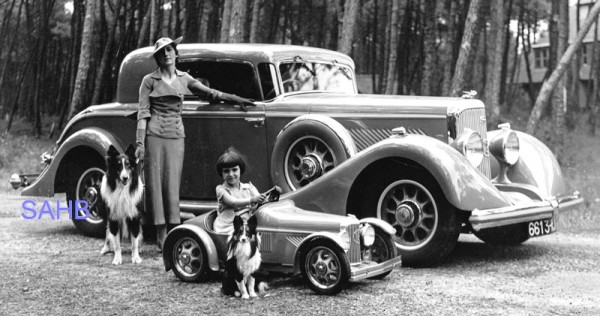
This photograph was bought not because of any particular desire to have a picture of a 1930s Panhard-Levassor but simply because it was felt that the complete ensemble had been so imaginatively created. And created with great care it was, so perhaps showing it here is somewhat improper as it is anything but an instantly taken snapshot. There are in fact quite a number of views of the same cast and props which were produced at a photoshoot prior to the 1934 concours d’élégance ‘season’ and this is without doubt the best of the resulting images.
The choreographer of the occasion with its clever duplication of cars, people, and dogs in contrasting sizes was the illustrator Alexis Kow who particularly during the inter-war period, but also after 1945, produced much dramatic artwork for the advertising of makes such as Delahaye, Hispano-Suiza, Hotchkiss, Peugeot, and Panhard-Levassor, amongst others. The stylishly dressed lady is Madame Kow, accompanied by her collie dog, whilst the pedal car in the foreground, in effect a miniature Panhard-Levassor, was marketed as a Euréka. Its ‘driver’ is a young lady borrowed for the occasion from the Théâtre du Petit Monde and the collie puppy was probably on loan as well.
As for the car itself, its long title was a: 6DS RL-N Spécial Type 74 Panoramique; this last word having been coined to emphasize the enhanced forward view for the driver and passengers that the newly introduced glazed screen pillars provided. Under the bonnet was a 6-cylinder 4¾-litre engine ‘sans soupapes’ – as the French had opted to call sleeve-valve engines from the time of their introduction.
A colour picture of this car shows that its faux cabriolet bodywork was finished in pale blue-grey with light yellow coachlining, so along with its size, style, and a top speed of around 90 mph, it is no surprise that it was intended for touring in the grand manner.
Given the economic climate of the times, few eyebrows are likely to be raised when it is disclosed that however imaginatively the cars were promoted, only 27 of these elegant Type 74 Panoramique models found customers between December 1933 and September 1937.






